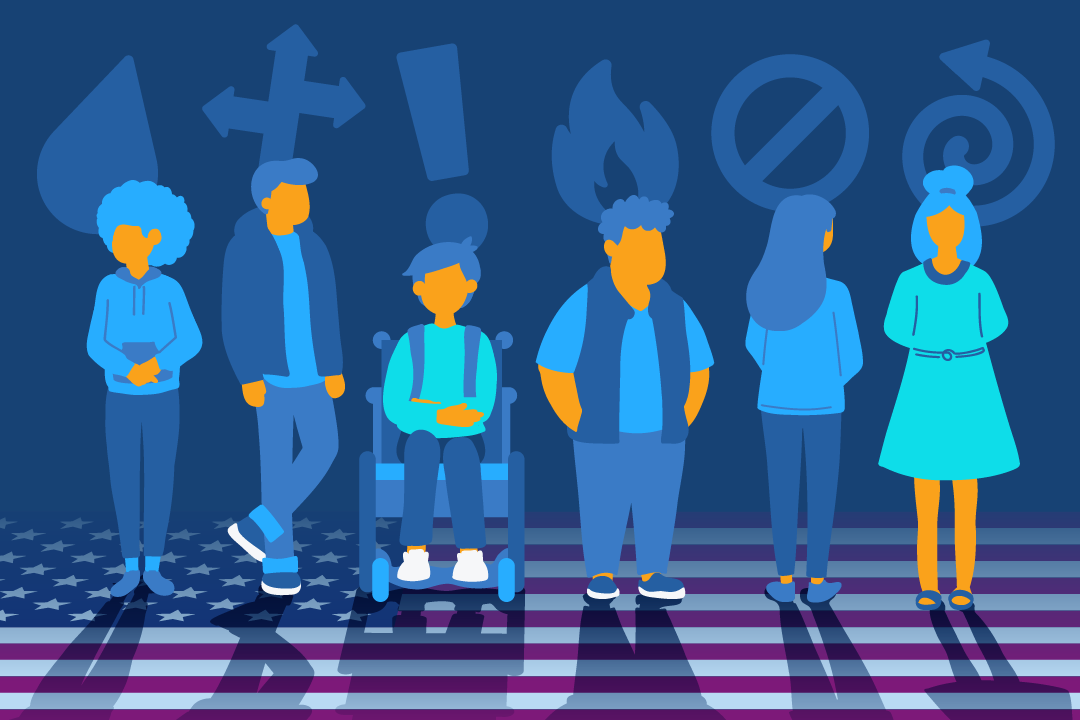
In January 2024, thousands of people earnestly responded to Elmo when the "Sesame Street" puppet prompted a mental health check-in on social media, asking, "How is everybody doing?"
The same week, in testimony before the Senate Judiciary Committee on the harms of social media to children, Republican Sen. Lindsey Graham accused Meta CEO Mark Zuckerberg—and CEOs of other social media sites—of having "blood on [their] hands" for a "product that's killing people."
Zuckerberg said directly to parents whose children died due to nefarious activity on social media: "It's terrible. No one should have to go through the things that your families have suffered." Internal research the company presented in March 2020 showed that Instagram use increased the rates of anxiety and depression in some teens, with 32% of teen girls saying that Instagram made them feel worse about their body image.
A similar share of teens (35%) said they use social media "almost constantly," according to Pew data collected in late 2023. University of California-San Francisco researchers found that the prevalence of conduct disorder among children rose 62% higher for each hour of social media use. As of November 2021, Forrester Research reported a staggering 63% of 12- to 17-year-olds used TikTok weekly.
Sandstone Care analyzed data from the Substance Abuse and Mental Health Services Administration to find the most common mental health diagnoses among teens in the U.S. in 2021, the latest data available.
According to the Centers for Disease Control and Prevention, about 15% of U.S. teens received mental health services in 2021. The National Council for Mental Wellbeing noted in 2021 that the average wait time to see a therapist is 48 days, but a "60 Minutes" report in 2023 found the wait time is often even longer for children.
Mental health issues in young people have been growing for more than a decade. When the COVID-19 pandemic hit, it upended many Americans' feelings of safety and security in their communities, places of work or school, and bank accounts.
Celebrities like Selena Gomez, Simone Biles, and Billie Eilish, who share their mental health struggles, reduce the stigma of the condition, according to 2022 research published in the Epidemiology and Psychiatric Sciences journal. This trend could be a catalyst for more young people seeking a diagnosis.
However, diagnostic testing for mental health is complex and can be imprecise, as symptoms of many mental health conditions overlap. For instance, symptoms may at first appear to be two separate disorders but could instead be a single disorder that puts a teen at risk of developing another.
The most common mental health diagnoses among teens in the U.S. in 2021—which Sandstone Care analyzed from the SAMHSA—was determined by calculating the share of individuals ages 12 to 17 who received a primary diagnosis of that disorder at a state-monitored mental health facility. Florida, Maine, Ohio, and South Dakota did not report sufficient data and were excluded from this report.
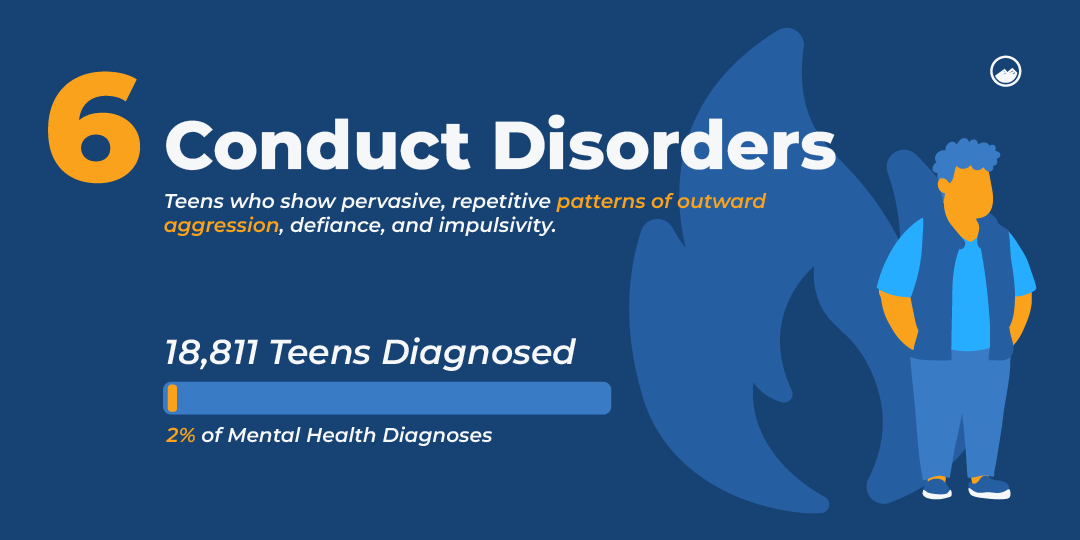
- Teens diagnosed: 18,811 (2% of all mental health diagnoses)
– Five-year change: -1.9 percentage points
Youth mental health is almost synonymous with anxiety, depression, and ADHD—yet conduct disorders affect 1 in 50 teens diagnosed with a mental health diagnosis. Conduct disorders is a catch-all term referring to children and teens who show pervasive, repetitive patterns of outward aggression, defiance, and impulsivity.
Certain behaviors may include mistreating animals, stealing, bullying, and vandalizing property. It's not entirely clear why CD presents in some children. Some experts believe that how children are raised factors into the equation, along with biology, social problems, and traumatic experiences.
During the pandemic, when rule-following was paramount, some researchers saw a rise in CD behaviors (not diagnoses) during lockdown.
A large-scale, longitudinal study on mental health in children published in Science Report found children's already severe mental health symptoms before the pandemic improved during the COVID-19 crisis—this could offer some insight into the slight drop in diagnoses over five years.
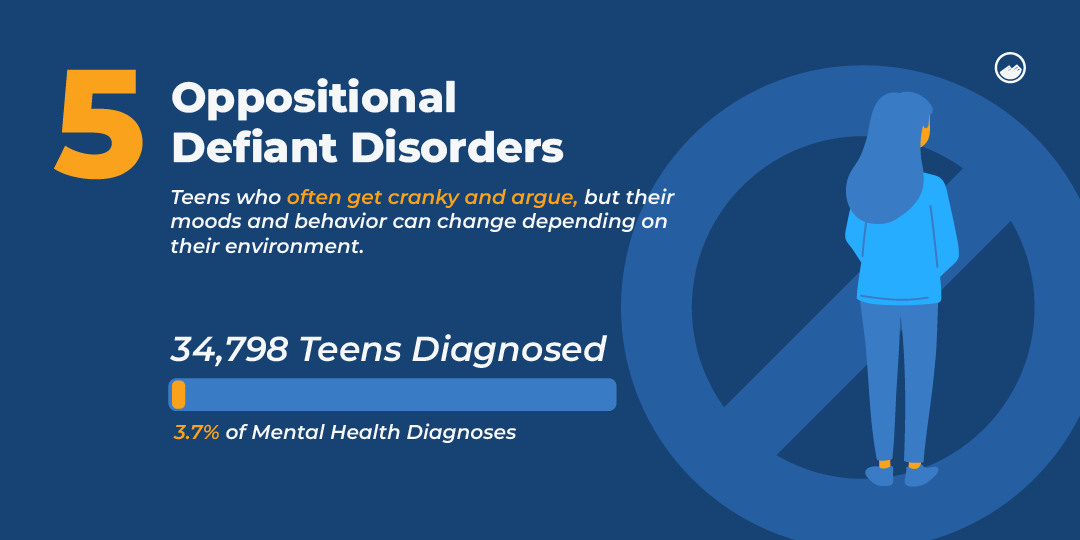
- Teens diagnosed: 34,798 (3.7% of all diagnoses)
– Five-year change: -2.1 percentage points
Oppositional defiant disorders exist on the same spectrum of behavioral disorders as conduct disorders and can be a precursor to CD. ODD symptoms may present more mildly than CD, with an angry or irritable mood or with argumentative, defiant, or vindictive behavior. ODD symptoms are temperamental, and behavior can depend on the setting or a reaction to one authority figure, operating like a switch, vacillating from fine to angry.
A 2022 study published in the Journal of Child Psychology and Psychiatry looking at screen time use and behavior conditions in children aged 9 to 11 found a link between screen times of over an average of four hours a day and a 49% higher prevalence of ODD. Jason Nagata, the study's lead author, said this could be attributed to the lack of sleep, exercise, and social connections from watching movies and playing video games.
ODD behaviors in adolescents dropped more significantly compared to younger children during the pandemic, according to 2021 research published in the European Journal of Psychotraumatology. This trend is partially due to the sustained impacts of psychotherapy treatment conducted before COVID-19. Prolonged health service interruptions and less time in the classroom where ODD can present may also have impacted the prevalence of diagnoses during the pandemic.
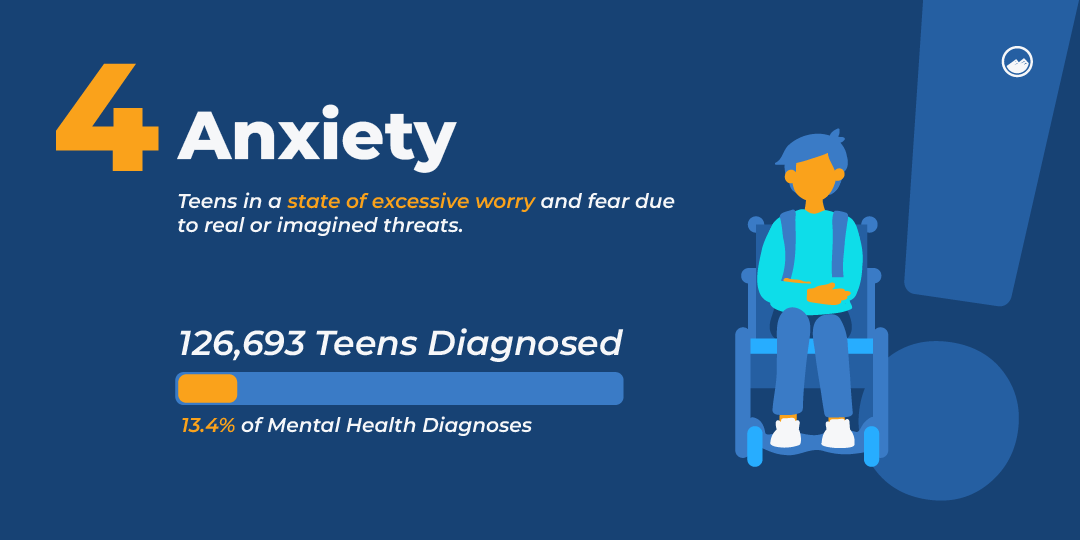
- Teens diagnosed: 126,693 (13.4% of all diagnoses)
– Five-year change: 4.5 percentage points
Anxiety is among the chief concerns of the U.S. surgeon general, who called youth mental health an "urgent public health crisis" in an advisory report in 2021.
Symptoms of anxiety look different for teenagers than they do for younger children, according to the Child Mind Institute. Teens feel more intense pressure and worry about performing "their absolute best" at school, CMI clinical psychologist Jerry Bubrick said. Teens may be highly anxious and vigilant about how others perceive them, which can manifest in debilitating social anxiety. They can also experience great distress about developing before or after their peers.
Experts hypothesize a rise in anxiety diagnoses due to the toll social media can take on self-esteem, increased pressure to excel in school, and an increasingly uncertain world. Thinking about issues in the news, like climate change, causes 37% of teens to feel anxious or even afraid, according to a 2022 EdWeek Research Center survey.
The World Health Organization reported in 2022 that the COVID-19 pandemic led to a significant rise in anxiety and depression worldwide. Youth showed a disproportionate risk of suicide and self-harm.
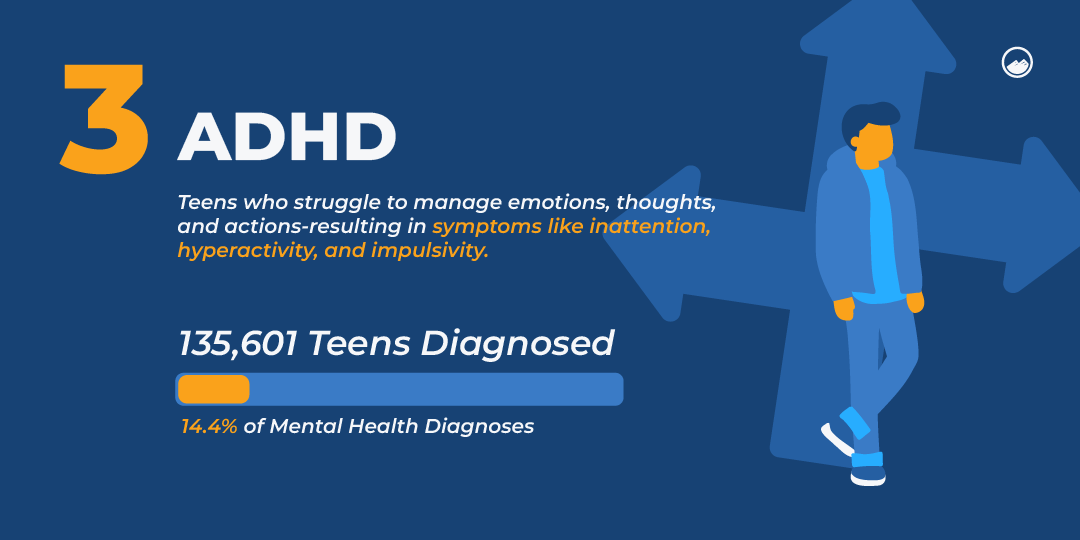
- Teens diagnosed: 135,601 (14.4% of all diagnoses)
– Five-year change: -1.5 percentage points
People with attention-deficit/hyperactivity disorder have a chronic brain condition that disrupts the ability to manage emotions, thoughts, and actions—resulting in symptoms like inattention, hyperactivity, and impulsivity. CDC data shows children assigned male at birth are diagnosed more than double than children assigned female at birth. Children AMAB present more obvious hyperactive tendencies than children AFAB, leading to historical over-representation in studies.
Teens with ADHD are generally less hyperactive than children with the condition. Yet, greater pressures in high school can make academics, relationships with peers, emotional regulation, driving, and risky behaviors like early cigarette, alcohol, and drug use a concern for teens with ADHD.
People with ADHD are easily affected by changes in their environment and education. A 2024 research review found that youth with ADHD had elevated symptoms and decreased emotion regulation skills during the pandemic, when much of school was held on Zoom, pointing in part to the effects of longer screen time.
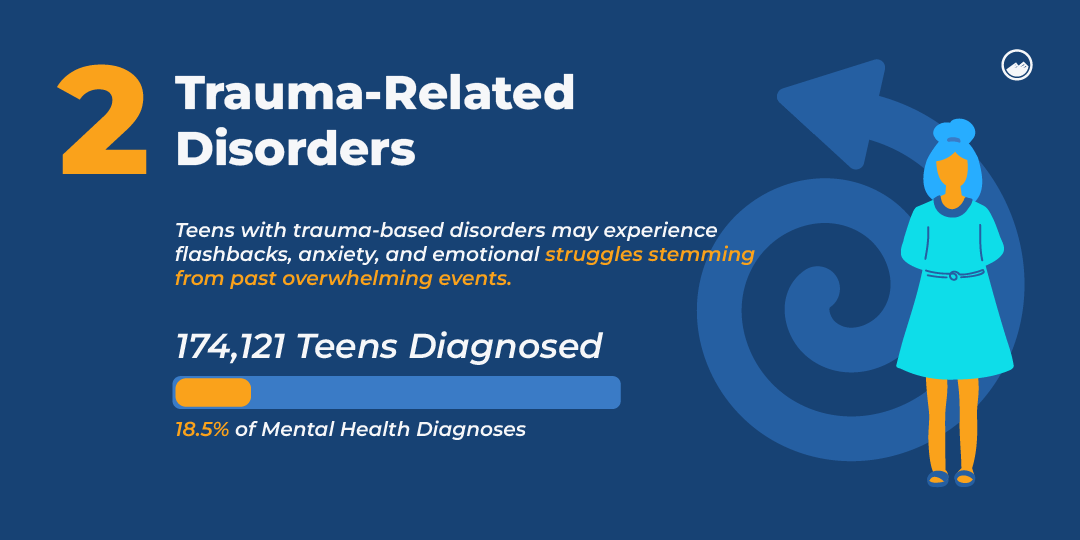
- Teens diagnosed: 174,121 (18.5% of all diagnoses)
– Five-year change: 2.5 percentage points
"Traumatic" is used loosely in the lexicon to exaggerate the annoyances of things like traffic, but "Big-T" trauma involves the lingering effects of events like natural disasters, death, and violence that impact daily life. Vera Feuer, a child and adolescent psychiatrist at Northwell Health, told NPR that most of the kids that she sees in psychiatric emergency rooms have experienced a form of victimization or bullying.
Very young children who experience traumatic events are more likely to have long-term adverse effects due to trauma-caused changes in the brain's structure during this important time of development.
Trauma impacts many other mental health conditions; however, the latest edition of the Diagnostic and Statistical Manual of Mental Disorders defines "trauma-related disorders" as post-traumatic stress disorder, reactive attachment disorder, disinhibited social engagement disorder, acute stress disorder, adjustment disorder, and unspecified trauma- and stressor-related disorder.
Steven Berkowitz, a psychiatry and pediatrics professor at the University of Colorado, wrote in a 2023 article for The Conversation that the cacophony of information, interactions, and bullying via social media, along with offline issues like unstable parents or violence in their environment, can cause trauma in young people. Black children are more likely to be exposed to trauma than white children.
In another article published in 2022 by The Conversation, two professors from Florida International University, Jonathan Comer and Anthony Steven Dick, discussed research that supports the fact that kids with preexisting neural vulnerabilities do not need to be close in proximity to traumatic events like disasters to feel the post-traumatic stress symptoms of the news thousands of miles away.
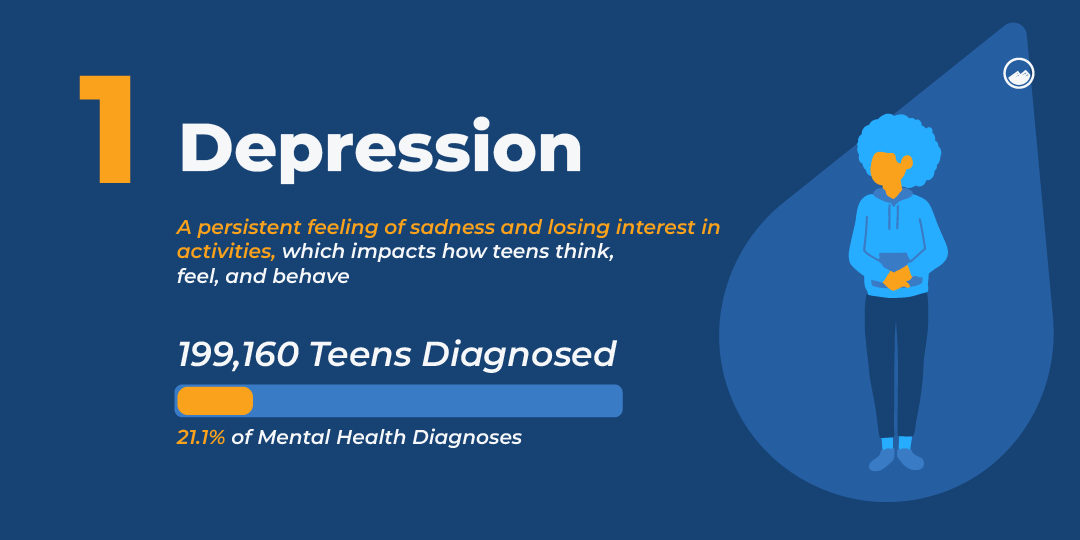
- Teens diagnosed: 199,160 (21.1% of all diagnoses)
– Five-year change: 1.7 percentage points
Teen depression is characterized by a persistent feeling of sadness and losing interest in activities, which impacts how teens think, feel, and behave. Girls reporting feelings of persistent sadness or hopelessness reached 57% in 2021, a 21% increase from the previous decade, according to CDC data (which was collected using a binary understanding of sex and gender). And 1 in 5 teens identifying as lesbian, gay, bisexual, or questioning reported they attempted suicide in 2021.
Seasonality impacts teens and children with depression, according to a CDC report, which found that far more emergency department visits occurred during school terms than in the summer. Other contributing factors to teen depression include changes in family structure, parental depression, and violence or neglect.
During the pandemic, a German study published in 2021 found that children and adolescents with depression were at greater risk of increased psychological distress than those with ADHD or with a conduct disorder.
There is some hope on the horizon: With an increase in mental health services in school, the CDC found that though the rate of teen girls' mental health-related visits to the emergency room in fall 2022 was at or higher than the baseline figures before COVID-19, fewer teens were admitted to emergency rooms for these issues during that time than in fall 2021.
Story editing by Shannon Luders-Manuel. Copy editing by Kristen Wegrzyn.
This story originally appeared on Sandstone Care and was produced and distributed in partnership with Stacker Studio.